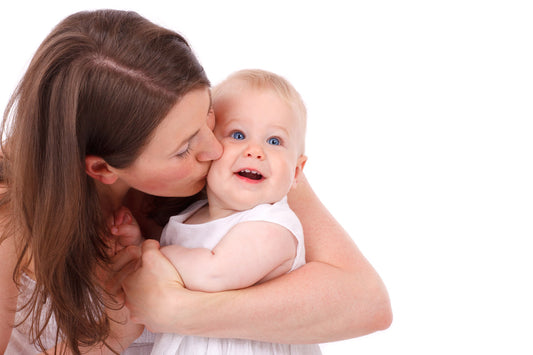Nappy rash will affect 1 in 3 babies before the age of 2. There are things you can do to help avoid these rashes and to treat them if and when they do occur.
First, its key to understand the 4 different types of rash....
BACTERIAL
Most rashes are an irritation of the skin caused or aggravated by contact with the wee and poo. The rash starts with a slight reddening of the skin in the nappy area and can progress to soreness and discomfort.
FRICTION
Nappy rash can be caused by chaffing or rubbing if skin is very sensitive or the nappy is the wrong size.
FUNGAL
A bright red, moist rash with white or red pimples which spreads to the folds of the skin, may indicate that your baby has a thrush infection and requires a prescribed cream.
ALLERGY
Occasionally nappy rash can become persistent and can be related to other skin conditions like eczema or allergies.
Bacterial Rash - Why do Babies get bacterial nappy rash?
- The most common type of nappy rash is a mild bacterial rash.
- The skin looks red and sore and can almost appear shiny.
- This is usually caused when the baby’s bottom is in contact with a wet or dirty nappy for a long period of time.
- A normal disposable nappy is made of plastic and traps heat and moisture inside. This combined with the wee or poo, makes a perfect breeding ground for bacteria.

Many parents note a nappy rash outbreak coincides with an event.
These events may change the alkalinity / acidity and bacterial content of their babies' excretions.
What you can do to avoid & treat mild bacterial nappy rash
1.Choose a breathable, natural material nappy
- Either disposable or reusable, natural materials can help to improve airflow and reduce the ‘plastic bag’ effect.
- Bamboo versions in particular have proven effective as they provide a natural antibacterial effect. Reviewers and award testers have noted that Mama Bamboo's nappies reduce nappy rash for their little ones. Our reviews often anecdotally report on the eradication of nappy rash
2.Change your baby often
- Change them as quickly as possible after they have pooed
- And change them regularly when they have weed
- A baby should be changed every couple of hours in the newborn stages; 10-12 nappy changes a day
3.Nappy free time
- Leave the nappy off for as long as possible to let fresh air get to their delicate skin
- Especially after a nappy change wait a few minutes to ensure your baby’s skin is totally dry before using a fresh nappy
4.Nappy cream
- You can use a barrier cream at the first sign of redness to prevent an outbreak
5.Avoid irritants
- Avoid using soaps, detergents or bubble bath that could irritate the skin
How to identify Severe Bacterial rash
- If not treated, a normal nappy rash can become infected. Assess your babies’ rash using the 5-scale chart below:

- Bacterial nappy rash can be identified as a 4-5 level rash, with broken skin, infected spots or pimples.
- Your baby is also likely to have a fever.
- This type of nappy rash may need antibiotics so it’s best to see your GP for advice, treatment and monitoring as soon as possible.
Friction Rash
A common cause of nappy rash is friction caused by the nappy rubbing against your baby’s delicate skin.
- Whether you use disposables or reusable do check the fit of the nappy.
- It should be snug around the tummy but not too tight – you should be able to fit your finger inside the waist band.
- The tabs should come around the sides and sit on the frontal sticky tape without having to cross over or meet – Most brands have a logo on their tape. You should sit be able to see this once the nappy is fastened.
- The leg ruching should not leave deep red indents in your babies’ skin. If it does, it is too tight.
- Conversely a too loose nappy can cause chafing between the thighs.
- Check the size chart on the nappies but remember every baby is different, so it may be a case of using your intuition.
Fungal rash
- This kind of rash can sometimes happen if your baby is on antibiotics or if they have thrush.
- A fungal rash shows as tiny red spots and the genitals can appear slightly swollen.
- This needs to be treated using an anti-fungal cream, available on prescription from your GP.
- This should be applied thinly to the affected area.
- If the nappy rash is fungal it is important that you avoid your usual barrier cream as this can make the condition worse.
Sensitivity or Allergy Rash
Normal nappies are made using:
-
Polypropylene
- Polyester
- Polyethylene
- Latex or PVC
- Chlorine bleached pulp
- SAP
- Adhesives
- Dyes
- Perfumes
- Lotions
That's right - normal nappies are +80% plastic. Polyester, Polyethylene, PVC, and Polypropylene. And they are wrapped in Plastic.
Bear in mind that, 3 billion plastic nappies went into landfill last year in the UK alone! These require 150 ml of crude oil in production per nappy. They also use harsh petrochemicals to process and most use chlorine bleach.
There are more skin-kind and earth-kind disposable versions available, like Mama Bamboo nappies which avoid the oil-based plastics, latex, PVC and chlorine and choose natural dyes, zero perfume or zero lotion

Mama Bamboo uses 100% bamboo viscose covers, chlorine free pulp, zero fragrance or lotion. We are also the only company to use 100% compostable liners and packaging.
Or you can try a reusable. Again bamboo or organic cotton covers are best for the babies' delicate skin.
If you are interested in comparing 'eco' disposable nappies, we have made a handy table in our blog: Compare eco friendly nappies
Wipes
In addition to your choice of nappies, your choice of baby wipes can have a great impact on your babies' skin.
Baby wipes are made up of 6 components:
- A fabric – polyester, polypropylene, bamboo, cotton or pulp
- Water - ideally over 99%
- Detergents to remove the dirt and reduce the need for scrubbing
- Moisturising agents
- Ph Balancers
- Preservatives
Some also include totally unnecessary fragrance
Whilst it is true that baby wipes should contain a high degree of water, it must be noted that water alone is not enough to effectively remove stubborn residues and prevent the growth of microorganisms or maintain a healthy skin pH
There are a few known ingredients in well known brands of baby wipes which are allergens or typical sensitivity triggers:
Wipe Watch List

The ingredients in Mama Bamboo's wipes are:
- Water: 99.4% purified water - and Aloe Vera
- Detergent: Tetrasodium EDTA
- Moisturiser: Coconut oil – disodium cocoamphondiacetate
- pH balancer: Citric Acid - alpha-hydroxy acid (AHAs)
- Preservatives: Sodium Benzoate, Potassium Sorbate
Everything you need and nothing you don't need.
Polyester & Polypropylene
11 billion plastic wet wipes went into landfill last year in the UK alone!
This is completely unnecessary. There are several good brands of fully compostable ones available.
Choose a 100% plant based zero plastic material like bamboo, wood pulp or organic cotton to avoid these and do your bit for the environment and stop using plastic wipes full stop.

Mama Bamboo wipes are made from 100% bamboo fibre. ZERO plastic. No pesticides or fertilizer. No irrigation. 100% certified sustainable crops
Should you use Cotton and Water?
So why chance it…should I use just cotton and water?……Well no!
Several independent clinical studies* have demonstrated that the use of modern baby wipes were superior to using water and cotton to clean delicate skin.
In all trials babies skin was visibly improved by using wipes:
- Better cleansing without scrubbing leading to a decrease in the severity of diaper rash in the folds
- Improvement in water loss and hydration
- Significantly lower pH balance (Higher alkalinity is linked to dryness)
- Better barrier function due to the moisturising impact.
Also cotton itself is highly polluting.
Cotton is one of the most water intensive crops to grow. And unless its organic cotton it uses a significant amount of pesticides as well. And most cotton wool and cotton pads are bleached in chlorine.
Nappy Cream
On the whole, you shouldn’t need a barrier cream with every nappy change. It really only needs to be applied when a little redness is beginning to show. And should only be used for a few days.
Some companies do advise you to use it with every change, but this should not be necessary.
There are many creams around and we would steer you towards natural, organic ingredients wherever possible.
Just like wipes you should look for the magic words…..
- Paraben free
- Phthalates free
- Petroleum free
- Fragrance free
Other things to specifically watch for include:
- Lanolin: Lanolin is essentially an excretion of a sheep's skin. The problem is that sheep are often sprayed directly with pesticides to fight off mites and other pests.
- Boric acid / sodium borate: This is a potential skin irritant, which is even worse because diaper rash cream is typically applied to broken skin
- Talc: On this point your grandmother is not correct! Talc is not a good thing to be adding to your babies’ bottom. It is very drying and irritating.
One thing your barrier cream should include is zinc or zinc oxide. Zinc should account for at least 5% of the formulation to be effective.
And it goes without saying you should be looking for the Leaping Bunny or Cruelty Free badges on all products.
Conclusion
Many babies do get nappy rash at some point. It does not mean you have done anything wrong.
There are things you can do to help avoid it but it may still happen occasionally:
- natural material nappies
- choosing a good fit nappy
- regular changes and immediate changes after a poo
- extra drying nappy free time
- gentle wipes
- avoiding allergens
If it does occur, there are things you can treat it with at home:
- more nappy free time
- check ingredients in your brands and make a swap
- use a barrier cream for a few days
However, if it doesn’t clear up within a few days, do seek medical advice – it could have developed into a bacterial infection or it may be a fungal infection.
Our mission is to make nappy rash a thing of the past.
*Referenced studies and articles:
1.Ehretsmann C, Schaefer P, Adam R. Cutaneous tolerance of baby wipes by infants with atopic dermatitis, and comparison of the mildness of baby wipe and water in infant skin. J Eur Acad Dermatology Venereol. 2001;15(Supplement 1):16‐21.
2.Lavender T, Furber C, Campbell M, et al. Effect on skin hydration of using baby wipes to clean the napkin area of newborn babies: assessor‐blinded randomised controlled equivalence trial. BMC Pediatr. 2012;12:59.
3.Adam R, Schnetz B, Mathey P, Pericoi M, de Prost Y. Clinical demonstration of skin mildness and suitability for sensitive infant skin of a new baby wipe. Pediatr Dermatol. 2009;26:506‐513.
4.Visscher M, Odio M, Taylor T, et al. Skin care in the NICU patient: effects of wipes versus cloth and water on stratum corneum integrity. Neonatology. 2009;96:226‐234.






